Introduction

In late 2023, Microsoft announced that they would be deprecating Windows Steps Recorder (also known as Problems Steps Recorder or PSR) in 2024.
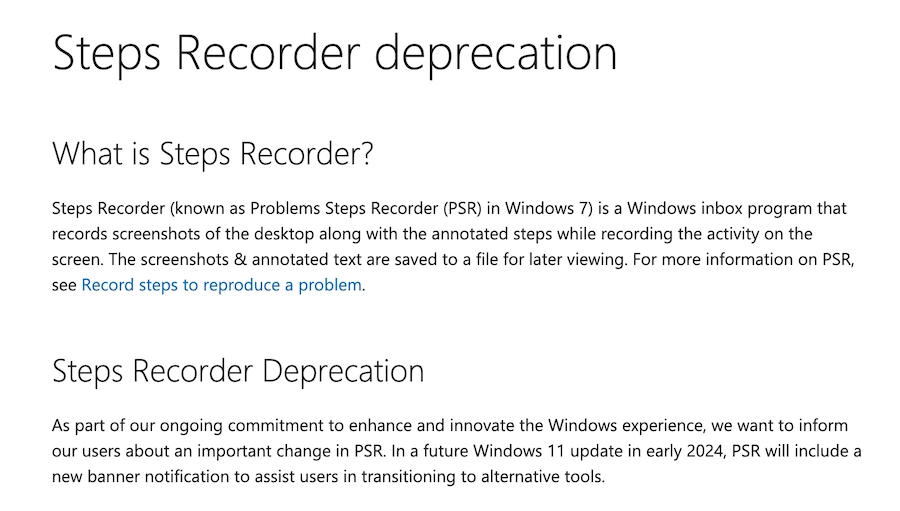
This leaves Windows teams without a screen recording tool to help them:
- Build training resources.
- Record problem steps and troubleshoot issues.
- Create user support documentation to support client needs.
- Create process documentation and build a robust knowledge base.
I’ll review both these tools in detail and give you a detailed breakdown of their features. My goal is to help you make an informed decision when choosing a solution that to best fit your team's needs.
Note: I’ve spent hours experimenting with Scribe and Steps Recorder to give you an unbiased, firsthand review. Even though you’re reading this review on the Scribe blog, you’ll only find an objective comparison of the two tools.
Scribe vs. MS Steps Recorder: which documentation tool should you choose? Takeaways:
- Functionality: Scribe promises advanced capabilities with the option to work with your team, access community resources and create an all-in-one knowledge management platform. On the other hand, Steps Recorder doesn’t have much to offer—except the promise of creating longer guides with up to 999 steps.
- User experience: Scribe is a much more intuitive platform with a user-friendly design and easy navigation. You can get started in seconds and fully adopt the platform quickly. Steps Recorder falls short in its UX with a basic interface and glitchy output.
- Customization: Scribe brings you a powerful editor with multiple customization options, such as annotating screenshots, redacting information, merging/deleting/adding steps and more. Steps Recorder doesn’t give you any customization features.
- Pricing and Price-to-Value: Scribe offers value-based pricing with a generous free plan and access to more features in its paid plans. You get great ROI for the paid options. But if you’re looking for a free tool, Steps Recorder can be a good option.
- Sharing capabilities: Scribe offers more dynamic sharing features where you can send your guides via a URL or embed them on any platform with a customizable embed code. You can also export your guides. However, Steps Recorder only lets you save files in the ZIP format and send them manually.
{{banner-short-v2="/banner-ads"}}
What is Scribe: a brief overview
Scribe is an AI-powered step recorder software designed to capture your mouse movements and keystrokes — turning them into visually appealing step-by-step guides.
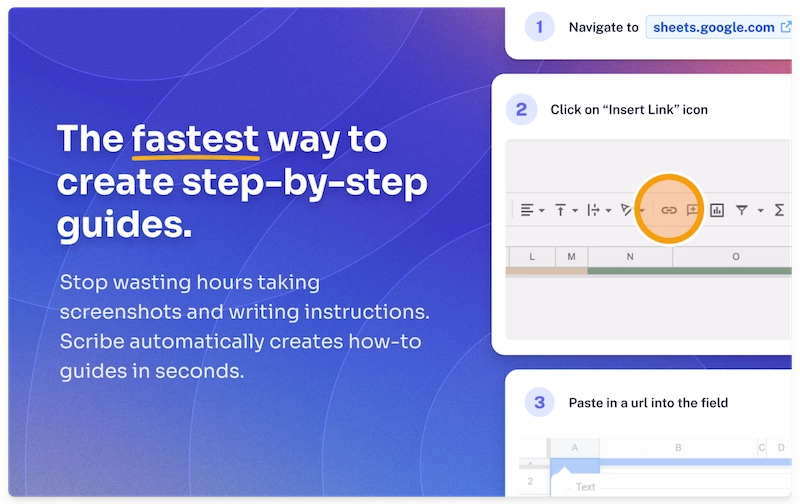
Scribe's step recorder software has both a free web browser extension for the basic plan, and a desktop app for Pro Personal and Teams users. This way, you can build step-by-step instructions for any process, across platforms.
Here's how to get started.
1. Create an account and download the web browser extension or desktop app
Then, click "Start Capture" to record your steps.

Scribe will follow along as you work to capture screenshots and auto-generate text to create step-by-step instructions.
2. Click "Stop Capture," to stop recording your screen
In seconds, Scribe builds a how-to guide complete with text and screenshots.
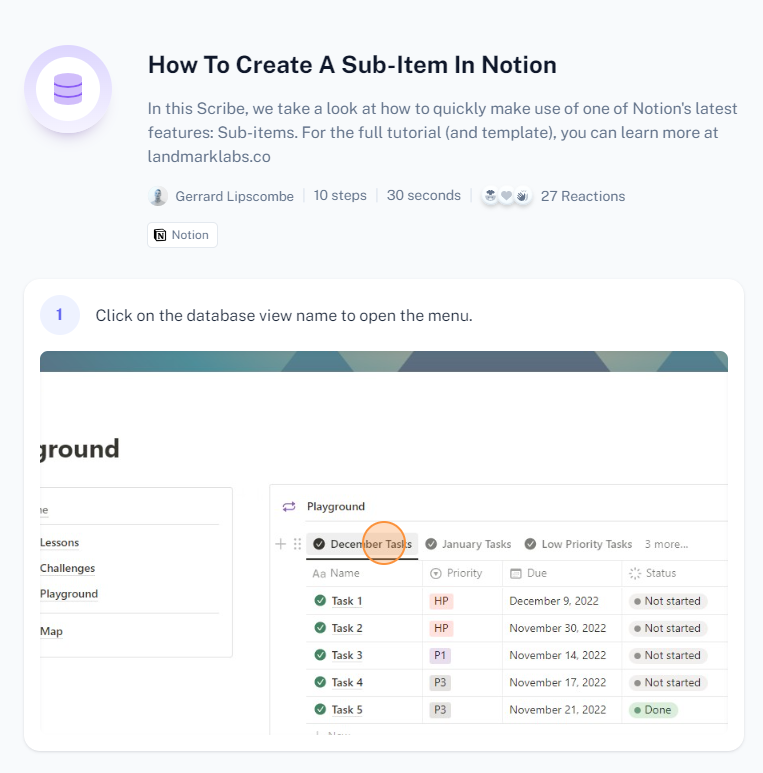
3. Customize your step-by-step instructions
Add or merge steps, generate a table of contents or combine several guides to build a larger standard operating procedure.
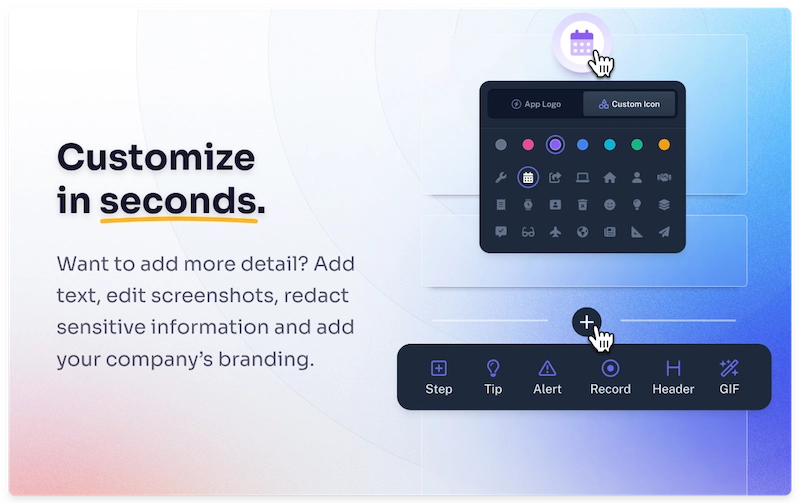
Pro Personal and Teams users also get additional features, like screenshot annotations, auto-redaction and Smart Blur and company branding.
4. Share or store in any knowledge base
Share your how-to guides with team members or customers via a quick link or embed in your favorite software program.
Your team members can also access your Scribes in the workspace, or right in their browser with Scribe Sidekick.
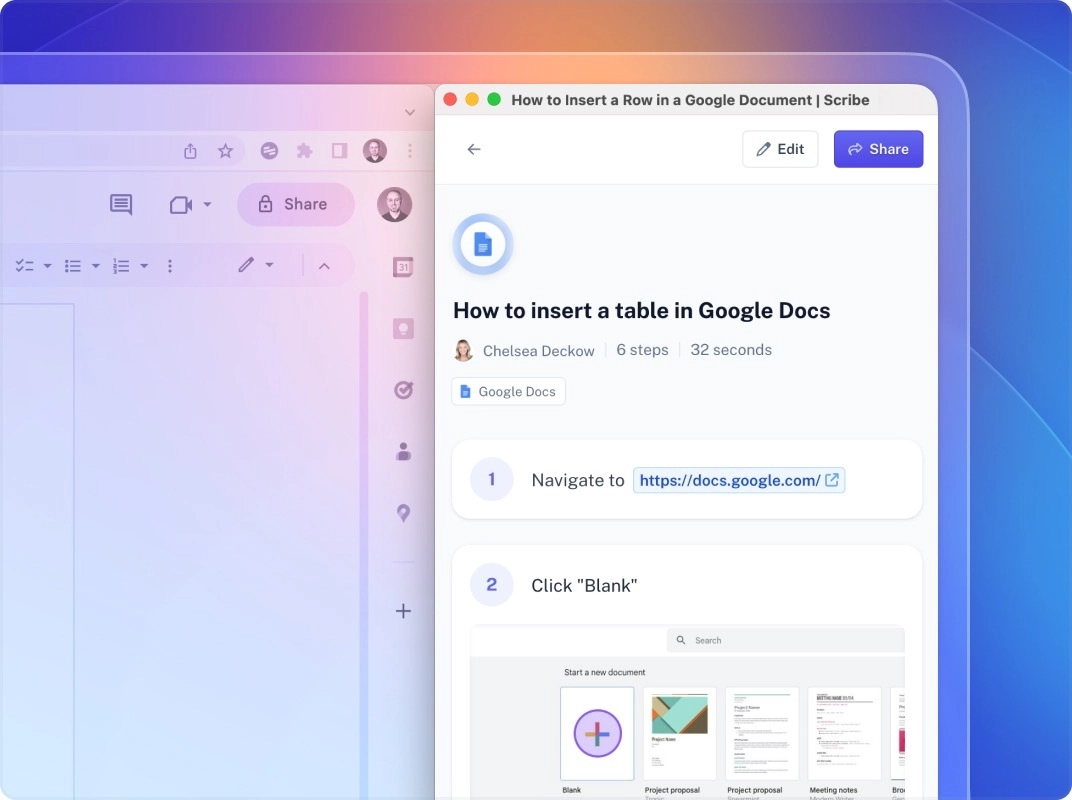
The best part about using Scribe is you don’t have to spend hours learning how to use the platform.
Its intuitive interface makes it easy for you to get started in a few seconds and hit the ground running.
Scribe screen recording tool features
Once you’re done recording a Scribe, you can customize it any way you want with a seamless editor. You can:
- Merge, combine or delete any step in bulk.
- Edit and format the text in each step with a rich-text editor.
- Add a new step, heading, tip, GIF or capture a new step from scratch.
- Customize the screenshots to add annotation and crop for smaller screens.
- Add your own brand colors and include your logo to create branded guides.
Let’s look at all the capabilities you can use in Scribe to create step-by-step guides:
AI-powered documentation
With Scribe Pages, you can use AI to combine multiple Scribes in a single document. Then add AI-generated text to build training manuals, standard operating procedures and user guides.
Embed videos, links and other media to make your document as unique as your processes.

Customization and free templates
Edit screenshots and steps to add or delete information. You can also redact sensitive details and create responsive guides for smaller screens.
Scribe also offers 100+ templates in our gallery so that you can build training manuals, software documentation and user documentation free of charge.
Smart sharing and collaboration tool
Get a smart embed code with flexible dimensions to embed anywhere.
You can also manage user-specific access with view/edit permissions. Offer access control so that team members can offer feedback and verify processes.
Analytics
Track your guides' performance to monitor your training materials. Scribe analytics keeps you on top of your company's documentation with real-time metrics.
Web app and mobile application
While the free basic plan lets you record processes on your browser, paid plans offer more flexibility and additional features.
Scribe’s desktop app makes it easy to capture your screen outside your browser. Pro and Teams Pro users can record tools and documents with a desktop version and mobile app.
Create guides for search optimization
Want to be recognized for your software documentation?
You can submit your guides to search engines for crawling and Scribe auto-fills meta-data to show your guides in organic search results.

Integrate with your knowledge base software
Scribe integrations with thousands of tools like ClickUp, HelpScout, Slack, Notion, monday.com and HubSpot to create a seamless process documentation workflow.
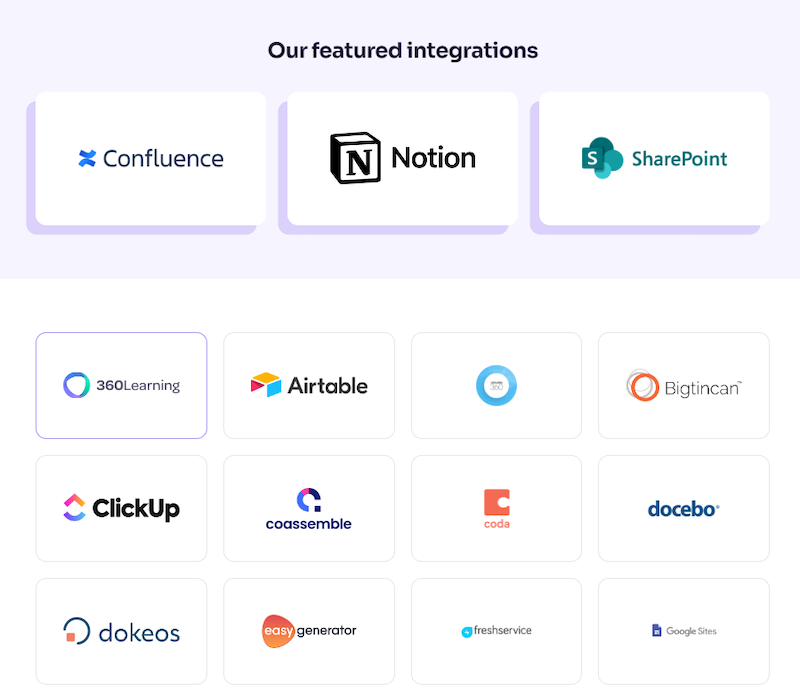
Scribe Pros & Cons
.tg {border-collapse:collapse;border-spacing:0;}
.tg td{border-color:black;border-style:solid;border-width:1px;font-family:Arial, sans-serif;font-size:14px;
overflow:hidden;padding:10px 5px;word-break:normal;}
.tg th{border-color:black;border-style:solid;border-width:1px;font-family:Arial, sans-serif;font-size:14px;
font-weight:normal;overflow:hidden;padding:10px 5px;word-break:normal;}
.tg .tg-1wig{font-weight:bold;text-align:left;vertical-align:top}
.tg .tg-0lax{text-align:left;vertical-align:top}
The Windows Step Recorder is a step recording software that captures screen actions and mouse movements.
Once you capture these steps, you can save them to a shareable file. This helps you walk a team member through a task, onboard a new customer or populate your central Wiki.
With the deprecation of this tool starting in 2024, Windows in-person and remote teams need a software documentation tool to enable team collaboration and customer support.
Steps Recorder is a system app in all Windows devices for recording steps to troubleshoot any issue. It’s called Problems Steps Recorder (PSR) on devices with Windows 7/8/8.1.
This built-in app is primarily used for detecting errors and diagnosing problems when users face any error in their system. You can record your entire screen, perform the steps that lead to the error and save the step-by-step file.
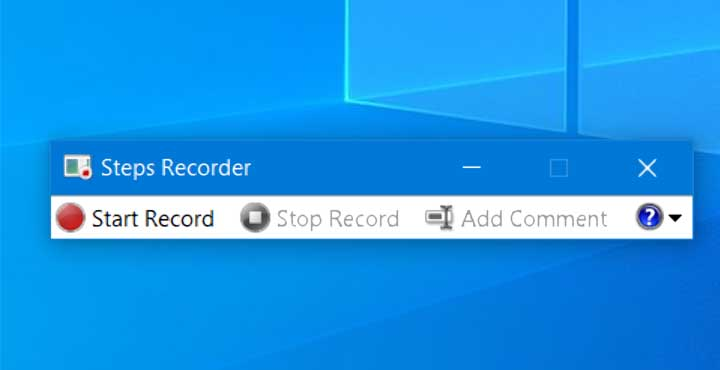
Instead of trying to explain a problem verbally or sending a bunch of screenshots, Steps Recorder gives you a convenient solution to capture all the steps leading up to the problem.
The tool captures your mouse clicks and explains the action in detail. You can also add comments for any step to include more context. Then, save this document as a ZIP file and share it with the IT team or a support executive to resolve the issue.
Alternatively, support teams can also use this tool to deliver help and instruct users on what to do when facing a challenge.
Other than recording steps, Steps Recorder doesn’t offer any additional functionalities.
While Microsoft recommends Snipping Tool as the official Steps Recorder alternative, Scribe is a much more powerful documentation software for digital processes.
Steps Recorder Pros & Cons
.tg {border-collapse:collapse;border-spacing:0;}
.tg td{border-color:black;border-style:solid;border-width:1px;font-family:Arial, sans-serif;font-size:14px;
overflow:hidden;padding:10px 5px;word-break:normal;}
.tg th{border-color:black;border-style:solid;border-width:1px;font-family:Arial, sans-serif;font-size:14px;
font-weight:normal;overflow:hidden;padding:10px 5px;word-break:normal;}
.tg .tg-1wig{font-weight:bold;text-align:left;vertical-align:top}
.tg .tg-0lax{text-align:left;vertical-align:top}
💡 More about Scribe's Step Recorder Software.
Scribe vs. Steps Recorder: The differences
While both Scribe and Steps Recorder help you create step-by-step documentation, they’re starkly different in their interface and overall capabilities. Let’s look at how the two tools compare against each other and which one’s the best for you.
Functionality (Winner: Scribe)
Scribe is available as a browser extension and desktop app for recording your screen. You can simply walk through a process or task you want to document and Scribe will capture all the steps to generate a neat step-by-step guide.
Your auto-generated guides include high-quality screenshots annotated with click marks, keyboard strokes and textual content. The tool also records any link you open during the recording. More importantly, you get a feature-packed editor to customize your guide.

The best part: unlike Steps Recorder, you can use Scribe on Windows, macOS and Linux operating systems. You can also access this for creating guides on mobile.
In contrast, Steps Recorder is a Windows native app. So, you can only access this tool as a Windows user. You might also face glitches if you’re using an older version of Windows. Another big limitation is that the tool captures your entire screen and you can’t crop these screenshots.
But one area where Steps Recorder takes an edge over Scribe is the number of steps it can capture. While Scribe lets you record 200 steps, Steps Recorder can easily capture 999 steps.
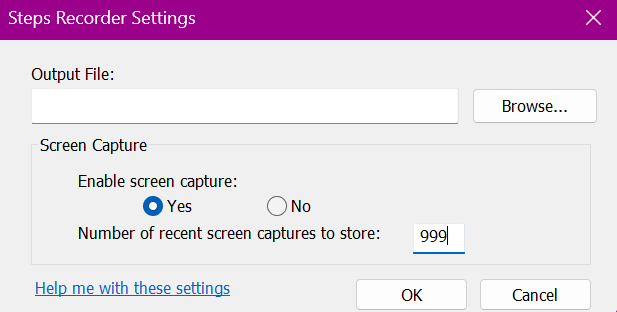
User experience (Winner: Scribe)
Scribe promises a seamless UX right from the get-go.
Neil, a long-time Scribe user, mentions how “The interface is clean and easy to understand and you can pick it up immediately.”
Getting started is as easy as toggling on the browser extension, choosing the tab/window you want to record and performing the process. Once you’re done recording your screen, you can edit the guide effortlessly and work with your team members to make specific changes.
Each editing capability is meaningfully designed to make your guides beautiful and user-friendly. You’ll also find tooltips like these 👇🏻 at crucial points in the app to help you discover new features.
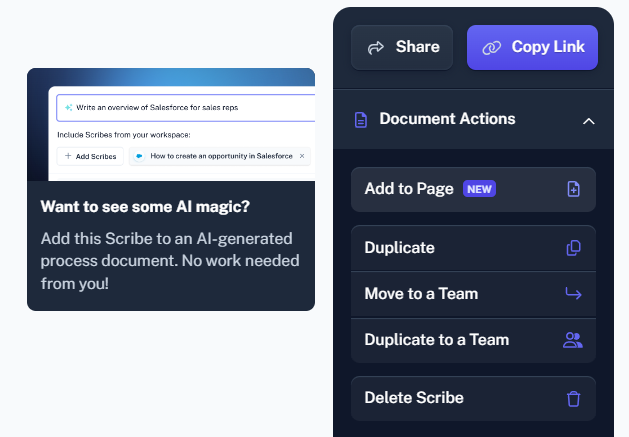
Scribe is also a pretty lightweight platform that doesn’t put too much pressure on your system. Even if you record a massive process, the tool won’t slow down your device or cause glitches.
On the other hand, Steps Recorder offers a pretty basic interface. When you launch the app, you’ll just see this small dialog box with one starting action and the settings.
Once you start recording, this dialog box will show up in your guides unless you minimize it.

When the recording is in progress, you have the option to pause it. But when it's complete, you can’t edit anything in the guide. That means, if you make a mistake while recording, you have to start from scratch and record everything again.
Another big point of friction in the user experience is the flawed output.
For one, Steps Recorder saves all documents as HTML ZIP files—which aren’t easily shareable or embeddable. It’s simply not as versatile and user-friendly as Scribe’s sharing options. Secondly, the output doesn’t show the screenshots properly.
Here’s what I could generate despite multiple attempts to create a guide 👇🏻

What seemed particularly problematic to me was the fact that this tool captures the entire screen and doesn’t let me crop the screenshot or redact any information. This defeats Steps Recorder’s primary purpose—share your system actions with support executives—because you can’t hide your personal details.
However, a point in favor of Steps Recorder is that it naturally takes less memory than Scribe. It’s important to note that Steps Recorder offers minimal capabilities and Scribe works like butter even with several advanced features.

Customization (Winner: Scribe)
Scribe takes a clear edge over Steps Recorder for editing your guides post-capture. With Scribe’s powerful editor, you can:
- Add, delete, combine and re-arrange steps.
- Directly insert a Scribe in an existing Page.
- Duplicate the guide or add it to a Team folder.
- Choose to collect comments from your team or end-users.
- Upload new screenshots or crop/annotate/blur existing ones.
- Display elements like author name, creation time, step count, etc.

Scribe also lets you create truly branded guides by adding your logo in the final output and choosing a custom color for the click marks. Besides, you can generate two types of content outputs: step-by-step guides and document pages—each ideal for different use cases.
On the other hand, Steps Recorder offers hardly any customization options. You can’t modify your steps after recording.
However, it’s possible to adjust the maximum number of steps you can record with its settings. You can also create a folder in your system to store all the new files.

The output looks like this with the text and screenshot. You can view the steps in the slideshow mode, but there’s no option to edit any part of the text or screenshot.
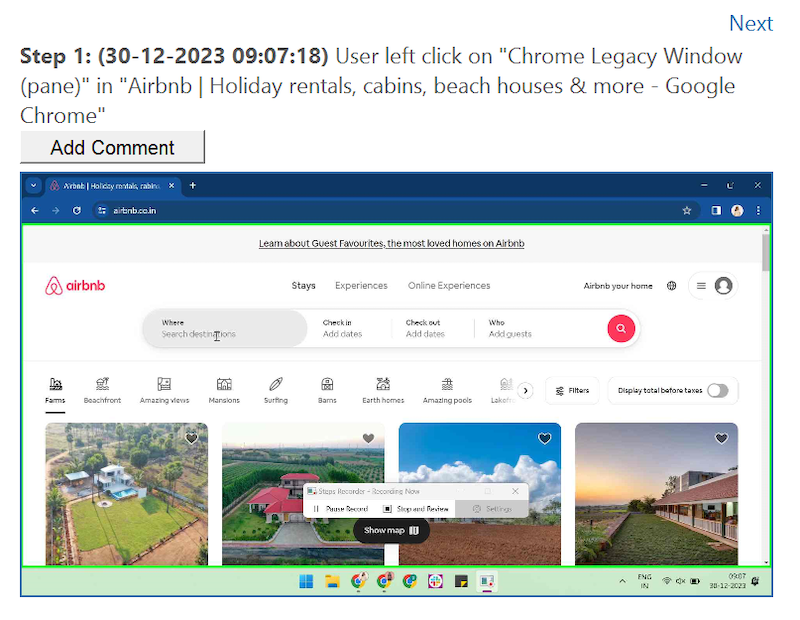
Pricing & Price-to-Value: (Winner: Steps Recorder)
Scribe gives you a generous free plan with the ability to create 25 guides for free. You can also access all essential customization options in the free plan. Plus, you can share your guides with a link and embed snippets.
Even the paid plans offer a great price-to-value ratio. The Pro plan unlocks more export options and editing features. You can also add your own branding and redact sensitive information. With the Enterprise plan, you can:
- Create multiple workspaces.
- Set up a single sign-in option.
- Auto-redaction of sensitive data.
- Designate role-based access control.
- Implement a review and approval process.
- A dedicated Customer Success Manager.
Essentially, Scribe offers value-based pricing to justify your spending.
However, Steps Recorder is a better bet if you’re looking for a free tool with unlimited guide creation options. The free tool has no paid capabilities and is built into all Windows systems. So, you don’t have to spend anything on recording steps.
Sharing capabilities (Winner: Scribe)
What makes Scribe even better is its dynamic sharing function. You can share your guides with a simple URL or copy a smart embed code with a customizable appearance.

Scribe also lets you share a guide with specific individuals via email. You can choose which users will have edit access and which ones can only view the doc. Since these guides are stored on the cloud in your Scribe account, you can access them anywhere by simply logging into your account.
You can also export your guides in different formats, including PDF, HTML, Markdown and Confluence. This is great for storing these files in your local drives or on Google Drive folders.
In contrast, Steps Recorder’s sharing capabilities are very limited. You can only save your guides as ZIP files for saving or sharing them. You won’t be able to open these guides without having access to your system.
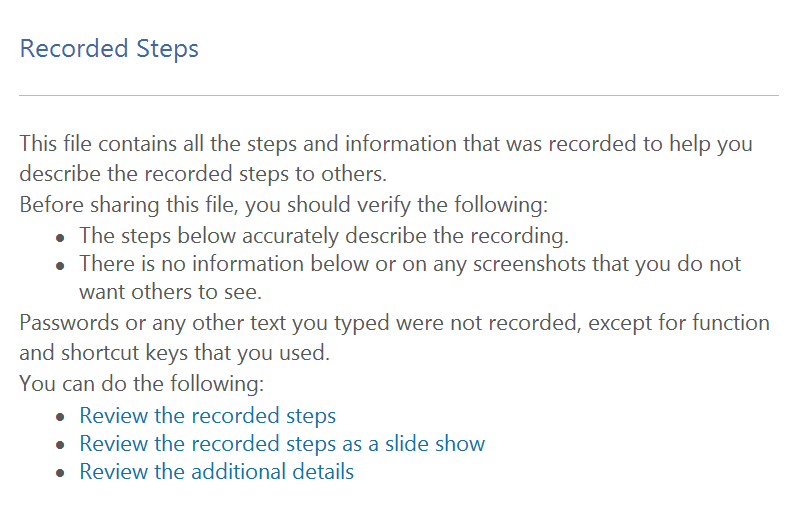
Scribe vs Steps Recorder: which documentation tool should you choose?
By now, you’d have made a clear choice between these tools. If you’re a Windows user and want a free, lightweight tool to generate basic guides, Steps Recorder is a good choice.
But if you want to create visually aesthetic yet functional step-by-step guides, Scribe is your go-to platform. With a great editor and smart sharing options, it’s a one-stop solution for documentation.
Try Scribe for free and see it for yourself.







